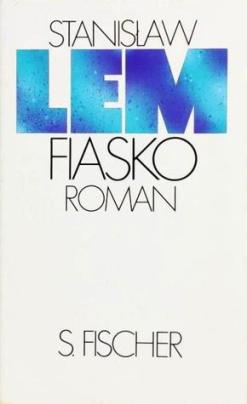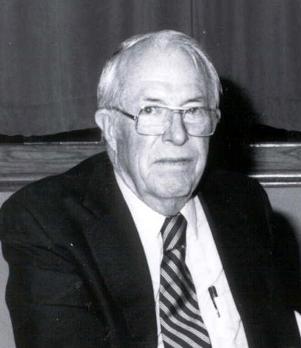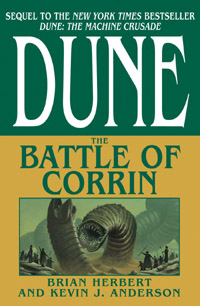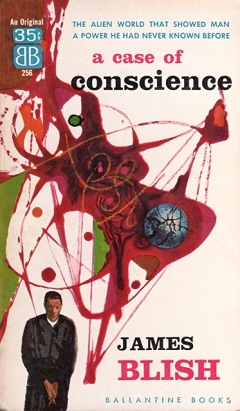The plot
The planet of Rathe and Home are locked into a deadly nuclear arms-race, each possessing weapons ready to launch a fiery consummation of the policy of Mutual Assured Destruction. Although satellite images show that Rathe possess only atomic (fission) weapons, less powerful than Home's thermonuclear arsenal, there is still enough megatonnage on each planet to totally destroy the other.
In a huge tent, a man almost dances a message out to the assembled masses. He whips up a frenzy of anti-Rathe sentiment, but as the crowd join in, he acts visibly and physically shocked, cowering and shaking. He begs the congregation to listen and to see reason before it is too late...
Both Rathe and Home are deserts - Rathe one of sand, Home one of water - and after a Naval expedition to observe a total solar eclipse (rare in the three-sun system of Rathe and Home) Aidregh - the Minister for the most powerful island nation on Home - is struggling to maintain the balance of power among his fellow ministers and prevent the terrible war that will result if a more xenophobic minister seizes power.
A secret crewed space-flight to a nearby planet of Home shows that Rathe had also visited the planetoid. This Home expedition also shows that Rathe has atomic 'firing plazas' each holding large enough atomic weapons to totally devastate Home. The Home expedition has been in flight for over a year, rushing back because of the importance of this news. As a result, the crew are exhausted. The captain dies suddenly of an embolism brought on by stress, lack of sleep and an overdose of amphetamine.
Unknown to the rest of Home, Aidregh has a microwave video-link to Rathe, which he uses to contact Margent, a Ratheman liaison. Margent and Aidregh discuss the feelings towards the war each planet has, and finally Margent suggests that a Home contingent, including Aidregh, visit Rathe to settle the problem once and for all. The rocket journey is scheduled for a year later.
Dr. Ni (an old friend of Aidregh) and his daughter, Aidregh and his son Aidresne and several other Home-men eventually arrive on Rathe. After being secluded for several days, they are reunited and Margent describes how his planet has 'lost its mind'. Rathe, it seems, is the home of telepathic and psionics that exploit what is known as Voisk forces. The psionic abilities are limited by connections - replacing a circuit-board from a computer will not stop it from working, as long as the board is replaced with a suitably connected schematic diagram. Margent - now revealed to be a title, not a name - is one of several Rathemen in charge (who all look worryingly similar to each other) describes how his world was once much more powerful in psionic powers than now. The war effort, it seems, and the need to think in terms of total destruction of another world, have effectively crippled what psionic ability the Rathemen once had.
To prevent the war, Margent suggests that Aidresne and his betrothed Corlant (who is Dr. Ni's daughter) be taught a psionic 'trick' that allows them to influence others' decisions. Aidregh and Ni strongly oppose this, because of the risks, and Aidregh himself volunteers.
Aidregh is painfully taught the trick of charisma that allows him to psionically project his feelings to others so that they might be influenced by it. Before an assembled audience of Rathemen, and at great risk to his own mind, he attempts this. Succeeding through great difficulty, the Rathemen agree it is time for the people from Home to return and convince their fellows that the war is unwinnable, and that there must be peace.
Aidregh gives a public talk, almost dancing his message. In a huge tent, he almost dances a message out to the assembled Home masses. He whips up a frenzy of anti-Rathe sentiment, but as the crowd join in, he acts visibly and physically shocked, cowering and shaking. Using the Voisk force he has been taught, Aidregh begs the congregation to listen and to see reason before it is too late... There is still time! This is where we and the grass grow up like music...'
Real-World Context
This novella was published during a critical period of the Cold War between the United States and the Soviet Union. The xenophobic mutual hostility felt by the inhabitants of Home and Rathe resembles the ideological and geopolitical struggle for global influence by these two superpowers, and the extreme tensions felt by various characters on each planet may be understood as comment by the author on the social psychology of that era.
A similar state of hostility, portrayed as open warfare between the Inner Planets and the Outer Satellites, is the setting of Alfred Bester's novel The Stars My Destination, published in 1956. Both Bester and Blish depict adversaries technologically capable of destroying each other, societies inhabited by characters who live with the emotional tensions of hatred and fear. Bester's setting emphasizes the separation between the antagonists, while Blish shows the inhabitants of each planet as fixated on the other's proximity.
Other science-fiction novels of the 1950s also employed settings of balanced hostility or warfare between two dominant societies. This pattern is visible in The Big Time, by Fritz Leiber, and Starship Troopers, by Robert Heinlein. Cyril M. Kornbluth wrote Not This August, published in 1955, an alternate history of open combat between the United States and allied Soviet and Chinese Communist forces, with the Communists victorious until developments at the end of the novel offer the unresolved possibilities of American victory or mutual assured destruction.

James Benjamin Blish was an American science fiction and fantasy writer. He is best known for his Cities in Flight novels and his series of Star Trek novelizations written with his wife, J. A. Lawrence. His novel A Case of Conscience won the Hugo Award. He is credited with creating the term "gas giant" to refer to large planetary bodies.

A doomsday device is a hypothetical construction — usually a weapon or weapons system — which could destroy all life on a planet, particularly Earth, or destroy the planet itself, bringing "doomsday", a term used for the end of planet Earth. Most hypothetical constructions rely on hydrogen bombs being made arbitrarily large, assuming there are no concerns about delivering them to a target or that they can be "salted" with materials designed to create long-lasting and hazardous fallout.

Fiasco is a science fiction novel by Polish author Stanisław Lem, first published in a German translation in 1986. The book, published in Poland the following year and translated into English by Michael Kandel in the same year, is a further elaboration of Lem's skepticism: in Lem's opinion, the difficulty in communication with extraterrestrial intelligence is more likely cultural disparity rather than spatial distance. It was nominated for the Arthur C. Clarke Award.

John Stewart Williamson, who wrote as Jack Williamson, was an American science fiction writer, one of several called the "Dean of Science Fiction". He is also credited with one of the first uses of the term genetic engineering. Early in his career he sometimes used the pseudonyms Will Stewart and Nils O. Sonderlund.
The concept of self-replicating spacecraft, as envisioned by mathematician John von Neumann, has been described by futurists and has been discussed across a wide breadth of hard science fiction novels and stories. Self-replicating probes are sometimes referred to as von Neumann probes. Self-replicating spacecraft would in some ways either mimic or echo the features of living organisms or viruses.

Dune: The Battle of Corrin is a 2004 science fiction novel by Brian Herbert and Kevin J. Anderson, set in the fictional Dune universe created by Frank Herbert. It is the third book in the Legends of Dune prequel trilogy, which takes place over 10,000 years before the events of Frank Herbert's celebrated 1965 novel Dune. The series chronicles the fictional Butlerian Jihad, a crusade by the last free humans in the universe against the thinking machines, a violent and dominating force led by the sentient computer Omnius.

A Case of Conscience is a science fiction novel by American writer James Blish, first published in 1958. It is the story of a Jesuit who investigates an alien race that has no religion yet has a perfect, innate sense of morality, a situation which conflicts with Catholic teaching. The story was originally published as a novella in 1953, and later extended to novel-length, of which the first part is the original novella. The novel is the first part of Blish's thematic After Such Knowledge trilogy and was followed by Doctor Mirabilis and both Black Easter and The Day After Judgment.

James Henry Schmitz was a German-American science fiction writer.

Spock Must Die! is an American science fiction novel written by James Blish, published February 1970 by Bantam Books. It was the first original novel based on the Star Trek television series intended for adult readers. It was preceded by a tie-in comic book line published by Gold Key and the novel Mission to Horatius by Mack Reynolds, all intended for younger readers.

Asteroids have appeared in fiction since at least the late 1800s, the first one—Ceres—having been discovered in 1801. They were initially only used infrequently as writers preferred the planets as settings. The once-popular Phaëton hypothesis, which states that the asteroid belt consists of the remnants of the former fifth planet that existed in an orbit between Mars and Jupiter before somehow being destroyed, has been a recurring theme with various explanations for the planet's destruction proposed. This hypothetical former planet is in science fiction often called "Bodia" in reference to Johann Elert Bode, for whom the since-discredited Titius–Bode law that predicts the planet's existence is named.

The World Jones Made is a 1956 science fiction novel by American writer Philip K. Dick, examining notions of precognition, humanity, and politics. It was first published by Ace Books as one half of Ace Double D-150, bound dos-à-dos with Agent of the Unknown by Margaret St. Clair.

Cities in Flight is a four-volume series of science fiction novels and short stories by American writer James Blish, originally published between 1950 and 1962, which were first known collectively as the "Okie" novels. The series features entire cities that are able to fly through space using an anti-gravity device, the spindizzy. The stories cover roughly two thousand years, from the very near future to the end of the universe. One story, "Earthman, Come Home", won a Retro Hugo Award in 2004 for Best Novelette. Since 1970, the primary edition has been the omnibus volume first published in paperback by Avon Books. Over the years James Blish made many changes to these stories in response to points raised in letters from readers.

Question and Answer is a science fiction novel by American writer Poul Anderson. It originally appeared in the June and July 1954 issues of magazine Astounding Science Fiction, and was later reprinted in 1956 as part of Ace Double D-199 under the title Planet of No Return, and again as a stand-alone Ace novel in February 1978 under the original title.
The Overmind is a fictional character appearing in American comic books published by Marvel Comics.

World War III, sometimes abbreviated to WWIII, is a common theme in popular culture. Since the 1940s, countless books, films, and television programmes have used the theme of nuclear weapons and a third global war. The presence of the Soviet Union as an international rival armed with nuclear weapons created persistent fears in the United States and vice versa of a nuclear World War III, and popular culture at the time reflected those fears. The theme was also a way of exploring a range of issues beyond nuclear war in the arts. U.S. historian Spencer R. Weart called nuclear weapons a "symbol for the worst of modernity."

Fictional planets of the Solar System have been depicted since the 1700s—often but not always corresponding to hypothetical planets that have at one point or another been seriously proposed by real-world astronomers, though commonly persisting in fiction long after the underlying scientific theories have been refuted. Vulcan was a planet hypothesized to exist inside the orbit of Mercury between 1859 and 1915 to explain anomalies in Mercury's orbit until Einstein's theory of general relativity resolved the matter; it continued to appear in fiction as late as the 1960s. Counter-Earth—a planet diametrically opposite Earth in its orbit around the Sun—was originally proposed by the ancient Greek philosopher Philolaus in the fifth century BCE, and has appeared in fiction since at least the late 1800s. It is sometimes depicted as very similar to Earth and other times very different, often used as a vehicle for satire, and frequently inhabited by counterparts of the people of Earth.

Northworld is a 1990 militaristic science fiction novel by David Drake set in a time when the Consensus rules everything except for Northworld, the missing planet. It is the first novel in the Northworld Trilogy. The other novels of the trilogy are Vengeance (1991) and Justice (1992).

Children of the Lens is a science fiction novel by American author E. E. Smith. It was originally serialized in the magazine Astounding beginning in 1947, and was first published in book form in 1954 by Fantasy Press in an edition of 4,874 copies. It is the last book in Smith's Lensman series.

The Love War (1970) is a science fiction ABC Movie of the Week starring Lloyd Bridges as an alien warrior and Angie Dickinson as the woman he befriends.

















